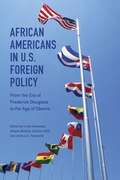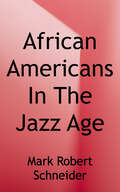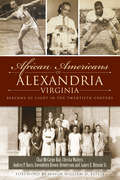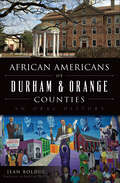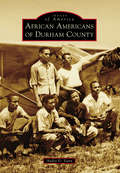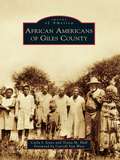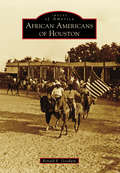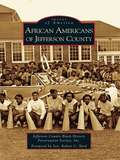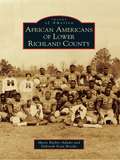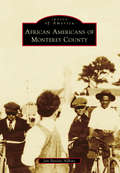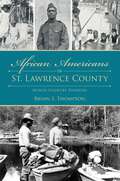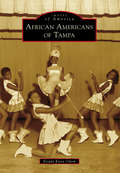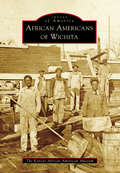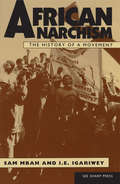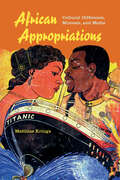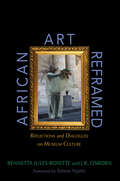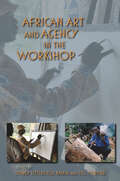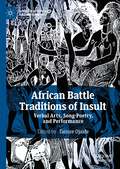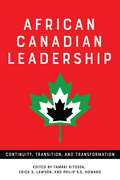- Table View
- List View
African Americans in U.S. Foreign Policy: From the Era of Frederick Douglass to the Age of Obama
by Linda Heywood Allison Blakely Charles Stith Joshua C. YesnowitzBookended by remarks from African American diplomats Walter C. Carrington and Charles Stith, the essays in this volume use close readings of speeches, letters, historical archives, diaries, and memoirs of policymakers and newly available FBI files to confront much-neglected questions related to race and foreign relations in the United States. Why, for instance, did African Americans profess loyalty and support for the diplomatic initiatives of a nation that undermined their social, political, and economic well-being through racist policies and cultural practices? Other contributions explore African Americans' history in the diplomatic and consular services and the influential roles of cultural ambassadors like Joe Louis and Louis Armstrong. The volume concludes with an analysis of the effects on race and foreign policy in the administration of Barack Obama. Groundbreaking and critical, African Americans in U.S. Foreign Policy expands on the scope and themes of recent collections to offer the most up-to-date scholarship to students in a range of disciplines, including U.S. and African American history, Africana studies, political science, and American studies.
African Americans in the Jazz Age: A Decade of Struggle and Promise
by Mark Robert SchneiderThe victorious end to the first World War offered hope to African Americans who had fought for freedom abroad and hoped to find it at home. In this new work, historian Mark R. Schneider analyzes the dynamic 1920s that saw the enormous migration of African Americans to Northern urban centers and the formation of important <p><p>African American religious, social and economic institutions. Yet, even with considerable efforts to promote civil rights and advancements in the arts, many African Americans in the rural south continued to live under conditions unchanged from a century before. African Americans in the Jazz Age recounts the history of this turbulent era, paying particular attention to the ways in which African Americans actively challenged Jim Crow and firmly expressed pride in their heritage. <p><p>Supplemented by primary sources, this work serves as an ideal introduction to this critical period in U.S. history and allows students to examine the issues first-hand and draw their own conclusions.
African Americans of Alexandria, Virginia: Beacons of Light in the Twentieth Century (American Heritage)
by Christa Watters James E. Henson Sr. Audrey P. Davis Gwendolyn Brown-Henderson Char McCargo BahSitting just south of the nation's capital, Alexandria has a long and storied history." "Still, little is known of Alexandria's twentieth-century African American community. Experience the harrowing narratives of trials and triumph as Alexandria's African Americans helped to shape not only their hometown but also the world around them. Rutherford Adkins became one of the first black fighter pilots as a Tuskegee Airman. Samuel Tucker, a twenty-six-year-old lawyer, organized and fought for Alexandria to share its wealth of knowledge with the African American community by opening its libraries to all colors and creeds. Discover a vibrant past that, through this record, will be remembered forever as Alexandria's beacon of hope and light.
African Americans of Davidson County (Images of America)
by Tonya A. LanierAfrican Americans were present in Davidson County long before it was officially formed from Rowan County in 1822. The exact time or place of settlement remains in question. They served not only in the stereotypical roles of farm laborers and house slaves but also as skilled traders, blacksmiths, furniture makers, and artisans. From Petersville, Southmont, Thomasville, Midway, Lexington, Belltown, Reeds, Churchland, and tiny areas in between, great men and women found a sense of stability. They made a life out of the scraps that were left behind. This collection of historical photographs is a textured look at African Americans in Davidson County. Images of community notables like A. B. Bingham, Charles England, Rev. A. T. Evans, and Etta Michael White and iconic structures like St. Stephen United Methodist Church, Dunbar High School, and the Hut, these photographs weave together stories that outline the African American journey.
African Americans of Durham & Orange Counties: An Oral History (American Heritage)
by Jean BolducDurham and Orange Counties have vibrant and active African American communities. Throughout the region's unjust past, generations have shown extraordinary strength and resolve. Floyd McKissick became the first African American student at the University of North Carolina School of Law after Thurgood Marshall argued for his admittance in court. The struggle for civil rights in Durham shaped the poetry of Jaki Shelton Green, one of the state's most esteemed wordsmiths. More recently, local leaders such as Michelle Johnson find the work of equality is far from over. Journalist and writer Jean Bolduc reveals the voices of Durham and Orange County African Americans in a series of inspirational oral histories.
African Americans of Durham County (Images of America)
by Andre D. VannDurham County, North Carolina, once called the “Chicago of the South” and the “Capital of the Black Bourgeoisie,” has long occupied an important place in the hearts and minds of those who called Durham County home. African Americans have played a vital role in the growth and development of the region over the years, from antebellum times to Reconstruction to the Civil Rights era and in the present. The African American citizens of this historic Tar Heel county share an impressive story marked by determination, economic achievement, and resilience, and they have made a difference in all walks of life—educational, religious, civic, and commercial. This pictorial history reflects upon the rich and vibrant role that African Americans played in the area following emancipation. In its earliest stages, residents in such neighborhoods as Hayti, Hickstown, Crest Street, Pearsontown, the West End, the East End, and Walltown each created sturdy surviving communities that have shaped Durham.
African Americans of Galveston (Images of America)
by Tommie D. Boudreaux Alice M. GatsonIn the 19th century, Galveston shores were a gateway for immigrants to Texas and destinations beyond. Slaves, the forced immigrants, were brought to Galveston as property for sale. The largest slave trade operation in Galveston was implemented by Jean Laffite, a pirate. His slave trade business began around 1818. However, for the most part, slaves entering the port of Galveston were destined for other Texas cities and other states. Images of America: African Americans of Galveston presents the community life and accomplishments of Galveston slaves, the descendants of slaves, and descendants of those who migrated to Galveston after the Civil War. The book celebrates Galveston's African American culture from the 1840s to the 1960s.
African Americans of Giles County (Images of America)
by Carroll Van West Tonya M. Hull Carla J. JonesGiles County was founded on November 14, 1809, and is known as the land of milk and honey. The county is home to over 30 National Register properties, Civil War skirmish sites, a varied cultural heritage, and intersecting Trail of Tears routes (Benge's and Bell's). It is also the beginning place for many well-known African Americans, such as noted architect Moses McKissack, founder of McKissack and McKissack. Giles County is a place where many ancestral lineages return home to their roots for research or to discover their rich African American history and heritage.
African Americans of Houston (Images of America)
by Ronald E. GoodwinTexas is a Southern state, and in many ways, Houston is a typical Southern city. While Houston did not experience the types or degrees of racial violence found in other Southern cities during the Jim Crow era, black Houstonians nonetheless found themselves often relegated to the margins of society. For decades there were two distinct Houstons: one white and the other black. However, Houston's black community created businesses that flourished and schools that educated children and developed a culture that celebrated the accomplishments of their parents while eagerly anticipating the accomplishments of future generations. Images of America: African Americans of Houston captures the many facets of black Houston. From churches to nightclubs; city parks to city hall; and political giants Barbara Jordan, Mickey Leland, and Sheila Jackson Lee to the driving beats of Archie Bell and the Drells, the Ghetto Boys, and Beyoncé, black Houston is alive with a determination that past injustices will never dampen the future opportunities for greatness.
African Americans of Jefferson County (Images of America)
by Inc. Sen. Robert Byrd Jefferson County Black History Preservation SocietyJefferson County can proudly claim a large number of firsts when it comes to African Americans in national history. The raid to free slaves that served as a catalyst for the Civil War was led by abolitionist John Brown in Harpers Ferry. The first man wounded in the rebellion was Heyward Shepherd, a free African American and a Jefferson County resident. Pres. Abraham Lincoln appointed Jefferson County native Martin Robison Delany as the first African American field officer of the Civil War. In 1906, the Niagara Movement, forerunner to the National Association for the Advancement of Colored People (NAACP), held its first meeting on American soil on the Storer College campus. The first woman to become the coach of a men's college basketball team was also an African American from Jefferson County. Additionally, the Colored Horse Show held in Charles Town was the first of its kind for African Americans.
African Americans of Lower Richland County (Images of America)
by Deborah Scott Brooks Marie Barber AdamsLower Richland County encompasses approximately 360 square miles in the heart of South Carolina's geographic center. The Wateree River cradles it to the east, and the Congaree River borders the south and southwest. Virginia settlers discovered this rich land over 250 years ago. They became wealthy planters and accumulated large land tracts, creating plantation systems that sustained the economy. From 1783 until 1820, cotton was the principal cash crop, and the slave population increased tremendously and played a vital role in the development of agriculture and the economy in the area.
African Americans of Monterey County (Images of America)
by Jan Batiste AdkinsPeople of African heritage have traveled to Monterey since the 1770s, when African Spaniard Alexo Nino, a ship's caulker, traveled with Fr. Junipero Serra to Monterey via the San Antonio. For centuries since Nino, black men and women migrated to the Monterey Bay area in search of a new life. In the 20th century, some African Americans established businesses, bought homes, and encouraged family members and friends to settle in Monterey County. Others pursued military careers. Out of these communities came churches, schools, service organizations, and social groups. For the next century, the history of Monterey County's African American communities have mirrored the nation's slow progress toward integration with triumphs and setbacks that have been captured in images of employment opportunities, churches, business successes, and political struggles.
African Americans of New Orleans (Images of America)
by Phoenix Savage Turry FluckerEnslaved Africans and free people of color of Louisiana deserve the title of "Founding Fathers" just as much as the French, the Spanish, and the Americans. In spite of their subjugated role as slaves, African Americans of Louisiana, and subsequently New Orleans, were contributors to the success of the state and the city far beyond their role within the labor force. Imported into the Louisiana Territory by John Law's Company of the Indies, enslaved Africans, fed on a pound of corn a day, gave birth to American figures of the 19th and 20th centuries. Mahalia Jackson, Louis Armstrong, Homer Plessy, Marie Laveau, Buddy Bolden, Julies Lion, Alice Dunbar-Nelson, the fighting men of the Louisiana Native Guard, Ernest "Dutch" Morial, and many other African Americans contributed to the growth and development of New Orleans. Every African American citizen of New Orleans is intrinsically connected to the city's cultural and political landscape.
African Americans of Round Top (Images of America)
by David CollinsRound Top's African American pioneers came into Texas in 1825 when Stephen F. Austin brought in 300 Anglo-Americans, and the people they enslaved, for the purpose of colonizing the area. Soon afterward, more slaves were bought in from other slaveholding states. After the Civil War ended, the descendants of these original Round Top pioneers began building their own community. Many earned money by toiling away in the cotton fields for the very men who had once enslaved them. Others earned money working as cowboys, washerwomen, barbers, or blacksmiths. In 1867, the group founded the Concord Missionary Baptist Church as a communal space for them to come together and pool their resources to buy their own land, build their own homes, and hire teachers, which led to the creation of the Concord Missionary Baptist Church Colored School. For generations, this school successfully educated freedmen, their children, and their descendants before finally closing its doors due to desegregation. Despite many challenges, they overcame obstacles that grew into a prosperous community.
African Americans of St. Lawrence County: North Country Pioneers (American Heritage)
by Bryan S. ThompsonDiscover the Black pioneers who shaped St. Lawrence County through grit and determination.From its origins as part of New France through the Civil War and eventual industrialization of the region, St. Lawrence County has been shapped by all too often overlooked Black families and individuals. Author Bryan S. Thompson reveals the history of the African American community in New York's North Country.
African Americans of Tampa (Images of America)
by Ersula Knox OdomTampa has a fascinating past that has been wonderfully documented with one exception: African Americans. This culturally rich community is virtually invisible in the eyes of history. Tampa's population exploded during the early 1900s, and the building boom universally required the skills and talents of African Americans, who provided services, labor, and entrepreneurship in a massive form. They played significant roles in everything from Tampa's wilderness era to its boomtown years and were key players in the first and second Seminole Wars with their Seminole alliance. African American soldiers captured Fort Brooke during the Civil War and fought in the Spanish-American War. Residents have endured Jim Crow, desegregation, and racial unrest yet thrived as entrepreneurs. Black Cubans, as part of the greater African American community, enabled Tampa's world-renowned cigar industry. The photographs found in this volume clearly illustrate Tampa's social and productive African American community.
African Americans of Wichita (Images of America)
by The Kansas African American MuseumThe African American community of Wichita is as old as the city itself, dating back to early pioneers, cowboys, and business figures. Once relatively integrated, Wichita became more segregated as the 20th century unfolded. In response, African Americans developed a lively neighborhood downtown with its own businesses, churches, schools, and organizations. World War II brought new populations to work in the aircraft industry and set the stage for profound changes. In the 1950s, a younger generation of leaders challenged racism and discrimination, unleashing a period of change that was both hopeful and painful. In recent years, the African American community has become more complex, with generations of established families joined by recent transplants, emigrants from Africa, and children of mixed marriages. While challenges remain, African Americans are more visible than ever before in local life, evident in politics, business, sports, and education.
African Anarchism
by Chaz Bufe Sam MbahAfrican Anarchism covers a wide range of topics, including anarchistic elements in traditional African socieites, African communalism, Africa's economic and political development, the lintering social, political, and economic effects of colonialism, the development of "African socialism, the failure of "African socialism, and a possible means of resolving Africa's ongoing crises.
African Appropriations: Cultural Difference, Mimesis, And Media
by Matthias KringsWhy would a Hollywood film become a Nigerian video remake, a Tanzanian comic book, or a Congolese music video? Matthias Krings explores the myriad ways Africans respond to the relentless onslaught of global culture. He seeks out places where they have adapted pervasive cultural forms to their own purposes as photo novels, comic books, songs, posters, and even scam letters. These African appropriations reveal the broad scope of cultural mediation that is characteristic of our hyperlinked age. Krings argues that there is no longer an "original" or "faithful copy," but only endless transformations that thrive in the fertile ground of African popular culture.
African Archaeology Without Frontiers: Papers from the 2014 PanAfrican Archaeological Association Congress
by Alex Schoeman Chapurukha M Kusimba Santores Tchandeu Dirk Seidensticker Adrianne Daggett Marilee Wood Laure Dussubieux Tim Forssman Kate Smuts Nick Wiltshire Akin Ogundiran Matthew Davies Caleb Adebayo Folorunso Timothy Kipkeu Kipruto Freda M’Mbogori Henrietta L Moore Emubosa Orijemie Festo W Gabriel Elinaza Mjema Philip de Barros Gabriella Lucidi NarcisseConfronting national, linguistic and disciplinary boundaries, contributors to African Archaeology Without Frontiers argue against artificial limits and divisions created through the study of ‘ages’ that in reality overlap and cannot and should not be understood in isolation. Papers are drawn from the proceedings of the landmark 14th PanAfrican Archaeological Association Congress, held in Johannesburg in 2014, nearly seven decades after the conference planned for 1951 was re-located to Algiers for ideological reasons following the National Party’s rise to power in South Africa. Contributions by keynote speakers Chapurukha Kusimba and Akin Ogundiran encourage African archaeologists to practise an archaeology that collaborates across many related fields of study to enrich our understanding of the past. The nine papers cover a broad geographical sweep by incorporating material on ongoing projects throughout the continent including South Africa, Botswana, Cameroon, Togo, Tanzania, Kenya and Nigeria. Thematically, the papers included in the volume address issues of identity and interaction, and the need to balance cultural heritage management and sustainable development derived from a continent racked by social inequalities and crippling poverty. Edited by three leading archaeologists, the collection covers many aspects of African archaeology, and a range of periods from the earliest hominins to the historical period. It will appeal to specialists and interested amateurs.
African Armies: Evolution And Capabilities
by Pauline H. Baker Bruce E. ArlinghausAfrican armies have undergone significant changes since African nations won independence from colonial rule. Once mainly small constabulary forces relegated to the maintenance of internal order, these armies have become larger, more modern institutions, largely in response to growing external security threats. Previous analyses have focused on African military units as political actors, with little or no attention paid to their actual abilities and desires to perform defense functions. This study examines the evolution of African armed forces, their impact on the societies in which they operate, and their current capabilities, with special attention to their effectiveness as military institutions.
African Art Reframed: Reflections and Dialogues on Museum Culture
by Bennetta Jules-Rosette J.R. OsbornOnce seen as a collection of artifacts and ritual objects, African art now commands respect from museums and collectors. Bennetta Jules-Rosette and J.R. Osborn explore the reframing of African art through case studies of museums and galleries in the United States, Europe, and Africa. The authors take a three-pronged approach. Part One ranges from curiosity cabinets to virtual websites to offer a history of ethnographic and art museums and look at their organization and methods of reaching out to the public. In the second part, the authors examine museums as ecosystems and communities within communities, and they use semiotic methods to analyze images, signs, and symbols drawn from the experiences of curators and artists. The third part introduces innovative strategies for displaying, disseminating, and reclaiming African art. The authors also propose how to reinterpret the art inside and outside the museum and show ways of remixing the results. Drawing on extensive conversations with curators, collectors, and artists, African Art Reframed is an essential guide to building new exchanges and connections in the dynamic worlds of African and global art.
African Art and Agency in the Workshop
by Till Förster Sidney Littlefield KasfirThe role of the workshop in the creation of African art is the subject of this revelatory book. In the group setting of the workshop, innovation and imitation collide, artists share ideas and techniques, and creative expression flourishes. African Art and Agency from the Workshop examines the variety of workshops, from those which are politically driven or tourist oriented, to those based on historical patronage or allied to current artistic trends. Fifteen lively essays explore the impact of the workshop on the production of artists such as Zimbabwean stone sculptors, master potters from Cameroon, wood carvers from Nigeria, and others from across the continent.
African Battle Traditions of Insult: Verbal Arts, Song-Poetry, and Performance (African Histories and Modernities)
by Tanure OjaideThis book explores the “battles” of words, songs, poetry, and performance in Africa and the African Diaspora. These are usually highly competitive, artistic contests in which rival parties duel for supremacy in poetry composition and/or its performance. This volume covers the history of this battle tradition, from its origins in Africa, especially the udje and halo of the Urhobo and Ewe respectively, to its transportation to the Americas and the Caribbean region during the Atlantic slave trade period, and its modern and contemporary manifestations as battle rap or other forms of popular music in Africa. Almost everywhere there are contemporary manifestations of the more traditional, older genres. The book is thus made up of studies of contests in which rivals duel for supremacy in verbal arts, song-poetry, and performance as they display their wit, sense of humor, and poetic expertise.
African Canadian Leadership: Continuity, Transition, and Transformation
by Tamari Kitossa Erica S. Lawson Philip S.S. HowardChallenging the myth of African Canadian leadership "in crisis," this book opens a broad vista of inquiry into the many and dynamic ways leadership practices occur in Black Canadian communities. Exploring topics including Black women’s contributions to African Canadian communities, the Black Lives Matter movement, Black LGBTQ, HIV/AIDS advocacy, motherhood and grieving, mentoring, and anti-racism, contributors appraise the complex history and contemporary reality of blackness and leadership in Canada. With Canada as a complex site of Black diasporas, contributors offer an account of multiple forms of leadership and suggest that through surveillance and disruption, practices of self-determined Black leadership are incompatible with, and threatening to, White "structures" of power in Canada. As a whole, African Canadian Leadership offers perspectives that are complex, non-aligned, and in critical conversation about class, gender, sexuality, and the politics of African Canadian communities.
